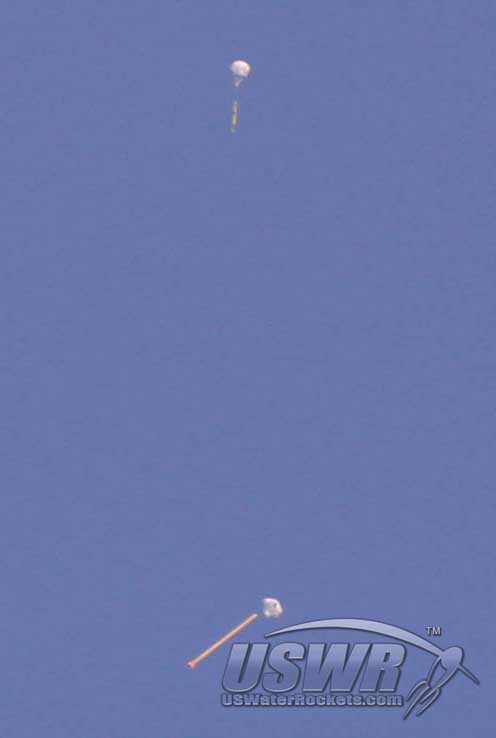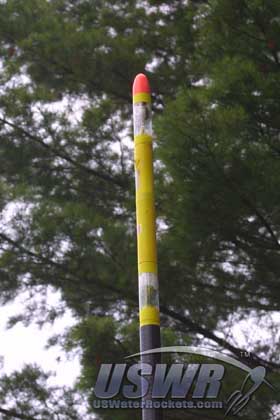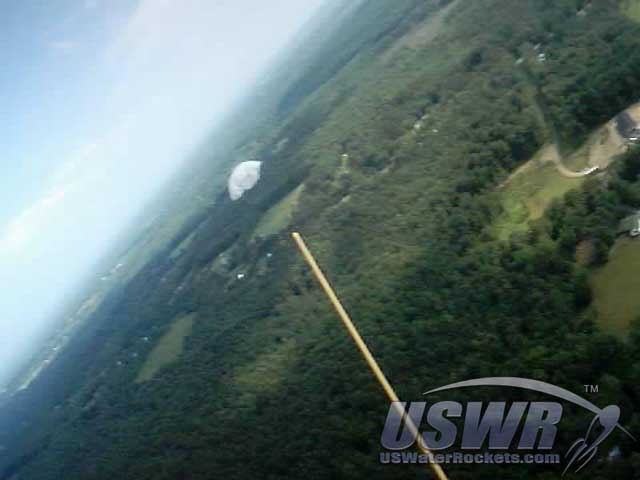The latest advances in recovery systems improves both safety and enhances functionality.

The X-9 Rocket is based on the Water Rocket toys made famous by Park Plastics in the 1950'sm which use compressed air propel the rocket skyward by forcing water out a nozzle. X-9 is the ninth in a series of experimental concepts currently being flight-tested by U.S. Water Rockets, and is made from a polycarbonate tube normally used as a protective cover for Fluorescent lamps. This type of Water Rocket is often referred to as an "FTC" Water Rocket, an acronym for "Fluorescent Tube Cover Water Rocket". Aerospace composite materials applied to the rocket provide added strength to the rocket without adding significant weight because composites are well known for their high strength to weight ratio.
One of the most problematic challenges in designing a rocket for a world record is the problem of how the rocket can be returned to the ground in a controlled manner. The U.S. Water Rockets team had initially planned to use a technique known as "backgliding" to recover their rocket. Backgliding is achieved by designing a fuselage which is aerodynamically stable when parallel to the ground. When the rocket reaches apogee, it leans over into this attitude and slows glides sideways back to the ground. Initial testing proved that this method functioned well, but the unpredictable winds in Upstate, New York proved to destabilize the gliding test rockets with alarming frequency. Making matters worse, their backgliding rockets had a tendency to coast off in unpredictable directions, making targeting a safe landing zone impossible. A better design was needed.
It seemed that a parachute system would be the best solution for the record attempts, but until that point, no system existed to reliably deploy a parachute from a water rocket. Traditional model rockets often use an explosive charge called a "squib" which is similar to a firecracker to deploy their parachutes. Since squibs are prohibited by the WRA2 world record competition rules, a different system was needed.
The system proved to have an extremely high success rate, and gave the team the confidence to begin experimenting with the camera payloads stipulated under the WRA2 rules. The video quality proved to be satisfactory, but "adequate" is not a term U.S. Water Rockets often applies to their designs.
An improvement to the system was inspired one day when Test Rocket X-8 accidentally came apart at the joint between the pressure vessel and the payload/electronics bay. The pressure vessel dropped off and fell in a slow and unstable manner to the ground, while the electronics/payload section floated to the ground on the parachute. The team quickly modified the electronics/payload section to include intentionally separate the rocket and deploy a parachute for each portion.
The revised scheme proved to be a resounding success and a quantum leap in safety. If either one or even both of the parachutes became tangled or failed to inflate, the separate rocket sections would be too unstable to fall ballistically to the ground. Instead, the sections would tumble slowly down, reducing the chance for injury or property damage on the ground due to a "lawn dart".
The team also learned that the payload section would descend for a longer duration with much less twisting and spinning motion, producing a much longer and smoother video of the descent phase. The team plans on using this system on all their future designs.
Flight Video:











